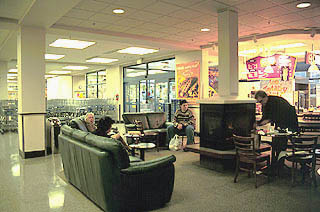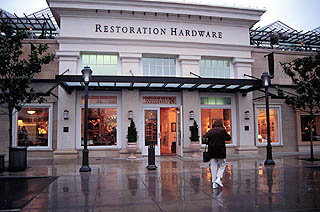|
Subscribe / Renew |
|
|
Contact Us |
|
| ► Subscribe to our Free Weekly Newsletter | |
| home | Welcome, sign in or click here to subscribe. | login |
Commercial Marketplace 1999
|
|
Retail forecast: ethnic malls and urban villages
By RICHARD MUHLEBACH Retail properties have a greater impact on a community than any other property type. A new or rehabbed shopping center or the addition of a major retailer often becomes a catalyst for additional neighborhood development. A successful retail development usually is the stimulus for another retail project, which then becomes the stimulus for yet another retail project and on and on. The best example of this phenomenon is the recent turn around in Seattles retail core. Once Nordstrom committed to locating its flagship store in a vacant department store, several retailers committed to downtown sites. Vacant buildings were remodeled and leased to trendy retailers and upscale restaurants. A second vertical mall was developed and connected by a skybridge to the new Nordstrom store. In just a few years, the direction of downtown Seattle changed from the typical big city central business district which is lifeless during the evenings and on weekends to one of only a few vibrant, 24-hour downtowns in America.
Woodinvilles downtown, once a row of strip centers with Molbaks Nursery as its big draw, now has a new retail development anchored by a major discounter, Target; a book store, Barnes & Noble; a giant supermarket, Top Foods; and the towns first multi-screen theater and several new retailers and restaurants. Both of these downtowns now retain sales from local residents that were lost to other communities. Theyve also gotten new jobs and convenient shopping.
Urban neighborhoodsShopping center developers and retailers have rediscovered urban neighborhoods. Infill retail projects anchored by a supermarket have been developed in lower Queen Anne, Capitol Hill and, in about a year, at Roosevelt and Northeast 65th. These areas have increased density and limited competition which translates to higher sales for retailers thus enabling them to pay the rents needed to justify the higher costs of urban projects. Retailers are flexible with their store designs and layouts to accommodate the configuration, size and restraints of urban sites. Residents welcome these urban developments because they bring back to their neighborhoods convenient shopping which has been missing for decades. Suburban shopping centers become obsolete faster than any other property type due to the ever-changing needs and formats of retailers. Once a shopping center becomes obsolete, secondary retailers move in, followed by vacancies. When these properties are rehabbed they come back to life with a new design, new major tenants and shop retailers. Major rehabs of community shopping centers are underway in Federal Way, Kent and the Southcenter area. An indicator of a healthy shopping center market is the diversity of new and rehabbed shopping center development in the area.
Rental ratesNew and rehabbed developments command the highest rents in their areas. The increased rents are necessary to economically justify these retail projects. The amazing turnaround of downtown Seattles retail core has pushed rents to between $40 and $75 per square foot, with the best locations renting for $85 per square foot. In just a few years, prime retail locations will exceed $100 per square foot. Belltown, a neighborhood that is transforming into a mini version of Chicagos State Street, with chic retailers, trendy restaurants and increased density, is achieving rents for retail and restaurant space in the $14 to $19 per square foot range. These rents have no where to go but up and up. Rents for downtown Bellevues high traffic retail corridors are in the $30 per square foot range while the rest of that area has rents in the high teens to low $20 per square foot.
Box stores are concentrated primarily in three areas: the Alderwood Mall area of Lynnwood, Southcenter and several small pocket areas on the Eastside. Box store rents are in the $14 to $19 per square foot range. All of the above-quoted rents are in the mid-range of market rents and there are always deals below and above these rates.
Ethnic malls and urban villagesTwo new types of shopping centers are developed every decade. The new shopping centers of the 90s are lifestyle centers such as Redmond Town Center, University Village and Crossroads Mall and entertainment centers like the soon-to-open Bellevue Galleria. The new or hot retail projects for the first decade of the 21st century will be urban villages and ethnic malls. The first ethnic mall in the Seattle area is under construction in Kent. A former 100,000-square-foot Home Base building is being converted into the Great Wall Shopping Mall. A very popular and successful California Asian supermarket, Ranch 99 Market, will anchor the mall which will have several Asian restaurants and unique specialty stores. Trends that will continue into the 21st century are rehabbing obsolete centers and infill retail urban developments. Urban villages will be the rage of the development industry during the next decade. Retailers and shopping centers are fighting the intrusion of home shopping networks and Internet shopping into territory they once dominated, by adding entertainment to the shopping experience. A peak into the future of retailing can be see at the successful Third Place Books which opened just a few months ago at Lake Forest Park Town Center in Lake Forest Park. Outstanding retail development, like Pacific Place in downtown Seattle, Redmond Town Center, University Village and the new Woodinville downtown project, along with creative and entertaining retailers like Third Place Books, are gifts to their communities.
Richard Muhlebach is president of TRF Management in Bellevue.
 djc home | top | special issues index
|


